Comparison between Measured and Calculated Thermal Conductivities within Different Grain Size Classes and Their Related Depth Ranges
Abstract
:1. Introduction
2. Materials and Methods
2.1. Soil Parameter
2.2. Thermal Conductivity Measurements
2.3. Data Analysis
2.4. Data Projection
3. Results
3.1. Bulk Density and Porosity
3.2. Thermal Conductivity
3.2.1. Thermal Conductivity Measurements
3.2.2. Thermal Conductivity Measurements vs. Kersten Formulas
3.2.3. Thermal Conductivity Measurements vs. ThermoMap Values
4. Discussion
5. Conclusions
Author Contributions
Funding
Acknowledgments
Conflicts of Interest
Nomenclature
| λ [W (m·K)−1] | thermal conductivity (TC) |
| ϕ [-] | porosity |
| ρb [g cm−³] | bulk density (BD) |
| ρs [g cm−³] | density, soil components |
| θW [-] | water content (WC) |
| Sp [-] | amount of saturated pore volume |
| md [g] | mass, dry |
| θ [-] | degree of saturation |
| Vc [cm3] | Volume, cylinder |
| n [cm3] | volume, fraction of air |
| ρb, eff [g cm−3] | bulk density, effective |
| vs [cm3] | volume, fraction of solids |
| nc [-] | amount of clay content |
References
- Bayer, P.; Saner, D.; Bolay, S.; Rybach, L.; Blum, P. Greenhouse gas emission savings of ground source heat pump systems in Europe: A review. Renew. Sustain. Energy Rev. 2012, 16, 1256–1267. [Google Scholar] [CrossRef]
- Blum, P.; Campillo, G.; Münch, W.; Kölbel, T. CO2 savings of ground source heat pump systems—A regional analysis. Renew. Energy 2010, 35, 122–127. [Google Scholar] [CrossRef]
- Dickinson, J.; Jackson, T.; Matthews, M.; Cripps, A. The economic and environmental optimisation of integrating ground source energy systems into buildings. Energy 2009, 34, 2215–2222. [Google Scholar] [CrossRef]
- Bense, V.F.; Kooi, H. Temporal and spatial variations of shallow subsurface temperature as a record of lateral variations in groundwater flow: Geothermal Data around Shallow Fault Zone. J. Geophys. Res. Solid Earth 2004, 109. [Google Scholar] [CrossRef]
- Hähnlein, S.; Bayer, P.; Ferguson, G.; Blum, P. Sustainability and policy for the thermal use of shallow geothermal energy. Energy Policy 2013, 59, 914–925. [Google Scholar] [CrossRef]
- Bertermann, D.; Bialas, C.; Morper-Busch, L.; Klug, H.; Rohn, J.; Stollhofen, M.P.; Jaudin, F.; Maragna, C.M.; Einarsson, G.M.; Vikingsson, S. ThermoMap—An open-source web mapping application for illustrating the very shallow geothermal potential in Europe and selected case study areas. In Proceedings of the European Geothermal Congress 2013, Pisa, Italy, 3–7 June 2013; pp. 1–7. [Google Scholar]
- Bertermann, D.; Klug, H.; Morper-Busch, L.; Bialas, C. Modelling vSGPs (very shallow geothermal potentials) in selected CSAs (case study areas). Energy 2014, 71, 226–244. [Google Scholar] [CrossRef]
- Bertermann, D.; Klug, H.; Morper-Busch, L. A pan-European planning basis for estimating the very shallow geothermal energy potentials. Renew. Energy 2015, 75, 335–347. [Google Scholar] [CrossRef]
- Dehner, U. Bestimmung der thermischen Eigenschaften von Böden als Grundlage für die Erdwärmenutzung. Mainz. Geowiss. Mitteilungen 2007, 35, 159–186. [Google Scholar]
- Hähnlein, S.; Bayer, P.; Blum, P. International legal status of the use of shallow geothermal energy. Renew. Sustain. Energy Rev. 2010, 14, 2611–2625. [Google Scholar] [CrossRef]
- Salata, F.; Nardecchia, F.; Gugliermetti, F.; de Lieto Vollaro, A. How thermal conductivity of excavation materials affects the behavior of underground power cables. Appl. Therm. Eng. 2016, 100, 528–537. [Google Scholar] [CrossRef]
- De Lieto Vollaro, R.; Fontana, L.; Vallati, A. Experimental study of thermal field deriving from an underground electrical power cable buried in non-homogeneous soils. Appl. Therm. Eng. 2014, 62, 390–397. [Google Scholar] [CrossRef]
- De Lieto Vollaro, R.; Fontana, L.; Vallati, A. Thermal analysis of underground electrical power cables buried in non-homogeneous soils. Appl. Therm. Eng. 2011, 31, 772–778. [Google Scholar] [CrossRef]
- Ocłoń, P.; Cisek, P.; Rerak, M.; Taler, D.; Rao, R.V.; Vallati, A.; Pilarczyk, M. Thermal performance optimization of the underground power cable system by using a modified Jaya algorithm. Int. J. Therm. Sci. 2018, 123, 162–180. [Google Scholar] [CrossRef]
- Janda, K.; Málek, J.; Recka, L. Influence of renewable energy sources on transmission networks in Central Europe. Energy Policy 2017, 108, 524–537. [Google Scholar] [CrossRef]
- Komendantova, N.; Battaglini, A. Social Challenges of Electricity Transmission: Grid Deployment in Germany, the United Kingdom, and Belgium. IEEE Power Energy Mag. 2016, 14, 79–87. [Google Scholar] [CrossRef] [Green Version]
- Gouda, O.E.S.; Osman, G.F.; Salem, W.; Arafa, S. Cyclic Loading of Underground Cables Including the Variations of Backfill Soil Thermal Resistivity and Specific Heat with Temperature Variation. IEEE Trans. Power Deliv. 2018. [Google Scholar] [CrossRef]
- Ocłoń, P.; Bittelli, M.; Cisek, P.; Kroener, E.; Pilarczyk, M.; Taler, D.; Rao, R.V.; Vallati, A. The performance analysis of a new thermal backfill material for underground power cable system. Appl. Therm. Eng. 2016, 108, 233–250. [Google Scholar] [CrossRef]
- Côté, J.; Konrad, J.-M. Thermal conductivity of base-course materials. Can. Geotech. J. 2005, 42, 61–78. [Google Scholar] [CrossRef]
- Logsdon, S.D.; Green, T.R.; Bonta, J.V.; Seyfried, M.S.; Evett, S.R. Comparison of Electrical and Thermal Conductivities for Soils From Five States. Soil Sci. 2010, 175, 573–578. [Google Scholar] [CrossRef]
- Ochsner, T.E.; Horton, R.; Ren, T. A new perspective on soil thermal properties. Soil Sci. Soc. Am. J. 2001, 65, 1641–1647. [Google Scholar] [CrossRef]
- Clauser, C. Einführung in Die Geophysik: Globale Physikalische Felder und Prozesse in der Erde; Lehrbuch; Springer Spektrum: Berlin/Heidelberg, Germany, 2014; ISBN 978-3-642-04495-3. [Google Scholar]
- Horai, K.; Simmons, G. Thermal conductivity of rock-forming minerals. Earth Planet. Sci. Lett. 1969, 6, 359–368. [Google Scholar] [CrossRef]
- Kersten, M.S. Thermal Properties of Soils. Available online: https://conservancy.umn.edu/handle/11299/124271 (accessed on 24 July 2018).
- Chaudhari, P.R.; Ahire, D.V.; Ahire, V.D.; Chkravarty, M.; Maity, S. Soil bulk density as related to soil texture, organic matter content and available total nutrients of Coimbatore soil. Int. J. Sci. Res. Publ. 2013, 3, 1–8. [Google Scholar]
- Saxton, K.E.; Rawls, W.J. Soil Water Characteristic Estimates by Texture and Organic Matter for Hydrologic Solutions. Soil Sci. Soc. Am. J. 2006, 70, 1569–1578. [Google Scholar] [CrossRef]
- Abu-Hamdeh, N.H. Thermal Properties of Soils as affected by Density and Water Content. Biosyst. Eng. 2003, 86, 97–102. [Google Scholar] [CrossRef]
- Abu-Hamdeh, N.H.; Reeder, R.C. Soil Thermal Conductivity Effects of Density, Moisture, Salt Concentration, and Organic Matter. Soil Sci. Soc. Am. J. 2000, 64, 1285–1290. [Google Scholar] [CrossRef]
- Bertermann, D.; Schwarz, H. Laboratory device to analyse the impact of soil properties on electrical and thermal conductivity. Int. Agrophys. 2017, 31, 157–166. [Google Scholar] [CrossRef] [Green Version]
- Farouki, O.T. Thermal Properties of Soils; Cold Regions Research and Engineering Laboratory: Hanover, NH, USA, 1981; p. 151. [Google Scholar]
- Lu, S.; Ren, T.; Gong, Y.; Horton, R. An Improved Model for Predicting Soil Thermal Conductivity from Water Content at Room Temperature. Soil Sci. Soc. Am. J. 2007, 71, 8–14. [Google Scholar] [CrossRef]
- Chen, S.X. Thermal conductivity of sands. Heat Mass Transf. 2008, 44, 1241–1246. [Google Scholar] [CrossRef]
- Haigh, S.K. Thermal conductivity of sands. Géotechnique 2012, 62, 617–625. [Google Scholar] [CrossRef]
- Lu, Y.; Lu, S.; Horton, R.; Ren, T. An Empirical Model for Estimating Soil Thermal Conductivity from Texture, Water Content, and Bulk Density. Soil Sci. Soc. Am. J. 2014, 78, 1859–1868. [Google Scholar] [CrossRef]
- Markert, A.; Bohne, K.; Facklam, M.; Wessolek, G. Pedotransfer Functions of Soil Thermal Conductivity for the Textural Classes Sand, Silt, and Loam. Soil Sci. Soc. Am. J. 2017, 81, 1315–1327. [Google Scholar] [CrossRef]
- Decagon Devices, Inc. KD2 Pro Thermal Properties Analyzer—Operator’s Manual; Decagon Devices, Inc.: Pullmann, WA, USA, 2016; p. 71. [Google Scholar]
- Seibertz, K.S.O.; Chirila, M.A.; Bumberger, J.; Dietrich, P.; Vienken, T. Development of in-aquifer heat testing for high resolution subsurface thermal-storage capability characterisation. J. Hydrol. 2016, 534, 113–123. [Google Scholar] [CrossRef]
- United States Department of Agriculture. USDA Textural Soil Classification; Soil Mechanics Level 1; USDA: Washington, DC, USA, 1987. [Google Scholar]
- Johansen, O. Thermal Conductivity of Soils; Corps of Engineers, U.S. Army, Cold Regions Research and Engineering Laboratory: Hanover, NH, USA, 1977. [Google Scholar]
- Wessolek, G.; Stoffregen, H.; Täumer, K. Persistency of flow patterns in a water repellent sandy soil—Conclusions of TDR readings and a time-delayed double tracer experiment. J. Hydrol. 2009, 375, 524–535. [Google Scholar] [CrossRef]
- Xiao, B.; Zhang, X.; Wang, W.; Long, G.; Chen, H.; Kang, H.; Ren, W. A Fractal Model for Water Flow through Unsaturated Porous Rocks. Fractals 2018, 26, 1840015. [Google Scholar] [CrossRef]
- Bodenkundliche Kartieranleitung: Mit 103 Tabellen und 31 Listen, 5th ed.; Sponagel, H. (Ed.) Verbesserte und Erweiterte Auflage; E. Schweizerbart’sche Verlagsbuchhandlung (Nägele und Obermiller): Stuttgart, Germany, 2005; ISBN 978-3-510-95920-4. [Google Scholar]
- Andersland, O.B.; Anderson, D.M. (Eds.) Geotechnical Engineering for Cold Regions; McGraw-Hill: New York, NY, USA, 1978; ISBN 0-07-001615-1. [Google Scholar]
- Blackwell, J.H. A Transient-Flow Method for Determination of Thermal Constants of Insulating Materials in Bulk Part I—Theory. J. Appl. Phys. 1954, 25, 137–144. [Google Scholar] [CrossRef]
- Davis, M.G.; Chapman, D.S.; Van Wagoner, T.M.; Armstrong, P.A. Thermal conductivity anisotropy of metasedimentary and igneous rocks. J. Geophys. Res. 2007, 112. [Google Scholar] [CrossRef] [Green Version]
- Watson, D.F.; Philip, G.M. A refinement of inverse distance weighted interpolation. Geo-Processing 1985, 2, 315–327. [Google Scholar]
- Park, J.; Santamarina, J.C. Revised Soil Classification System for Coarse-Fine Mixtures. J. Geotech. Geoenviron. Eng. 2017, 143, 04017039. [Google Scholar] [CrossRef]
- Renger, M.; Bohne, K.; Facklam, M.; Harrach, T.; Riek, W.; Schäfer, W.; Wessolek, G.; Zacharias, S. Ergebnisse und Vorschläge der DBG-Arbeitsgruppe „Kennwerte des Bodengefüges “zur Schätzung bodenphysikalischer Kennwerte; DBG-Arbeitsgruppe: Berlin, Germany, 2008. [Google Scholar]
- Alrtimi, A.; Rouainia, M.; Haigh, S. Thermal conductivity of a sandy soil. Appl. Therm. Eng. 2016, 106, 551–560. [Google Scholar] [CrossRef]
- Zhang, T.; Cai, G.; Liu, S.; Puppala, A.J. Investigation on thermal characteristics and prediction models of soils. Int. J. Heat Mass Transf. 2017, 106, 1074–1086. [Google Scholar] [CrossRef]
- Cosenza, P.; Guérin, R.; Tabbagh, A. Relationship between thermal conductivity and water content of soils using numerical modelling. Eur. J. Soil Sci. 2003, 54, 581–588. [Google Scholar] [CrossRef]
- Brigaud, F.; Vasseur, G. Mineralogy, porosity and fluid control on thermal conductivity of sedimentary rocks. Geophys. J. Int. 1989, 98, 525–542. [Google Scholar] [CrossRef] [Green Version]
- Tarnawski, V.-R.; Leong, W.H. Thermal Conductivity of Soils at Very Low Moisture Content and Moderate Temperatures. Transp. Porous Media 2000, 41, 137–147. [Google Scholar] [CrossRef]
- Ediger, V.Ş.; Hoşgör, E.; Sürmeli, A.N.; Tatlıdil, H. Fossil fuel sustainability index: An application of resource management. Energy Policy 2007, 35, 2969–2977. [Google Scholar] [CrossRef]
- Fridleifsson, I.; Bertani, R.; Huenges, E.; Lund, J.W.; Rybach, L. The Possible Role and Contribution of Geothermal Energy to the Mitigation of Climate Change; Intergovernmental Panel on Climate Change (IPCC): Geneva, Switzerland, 2008; pp. 59–80. [Google Scholar]
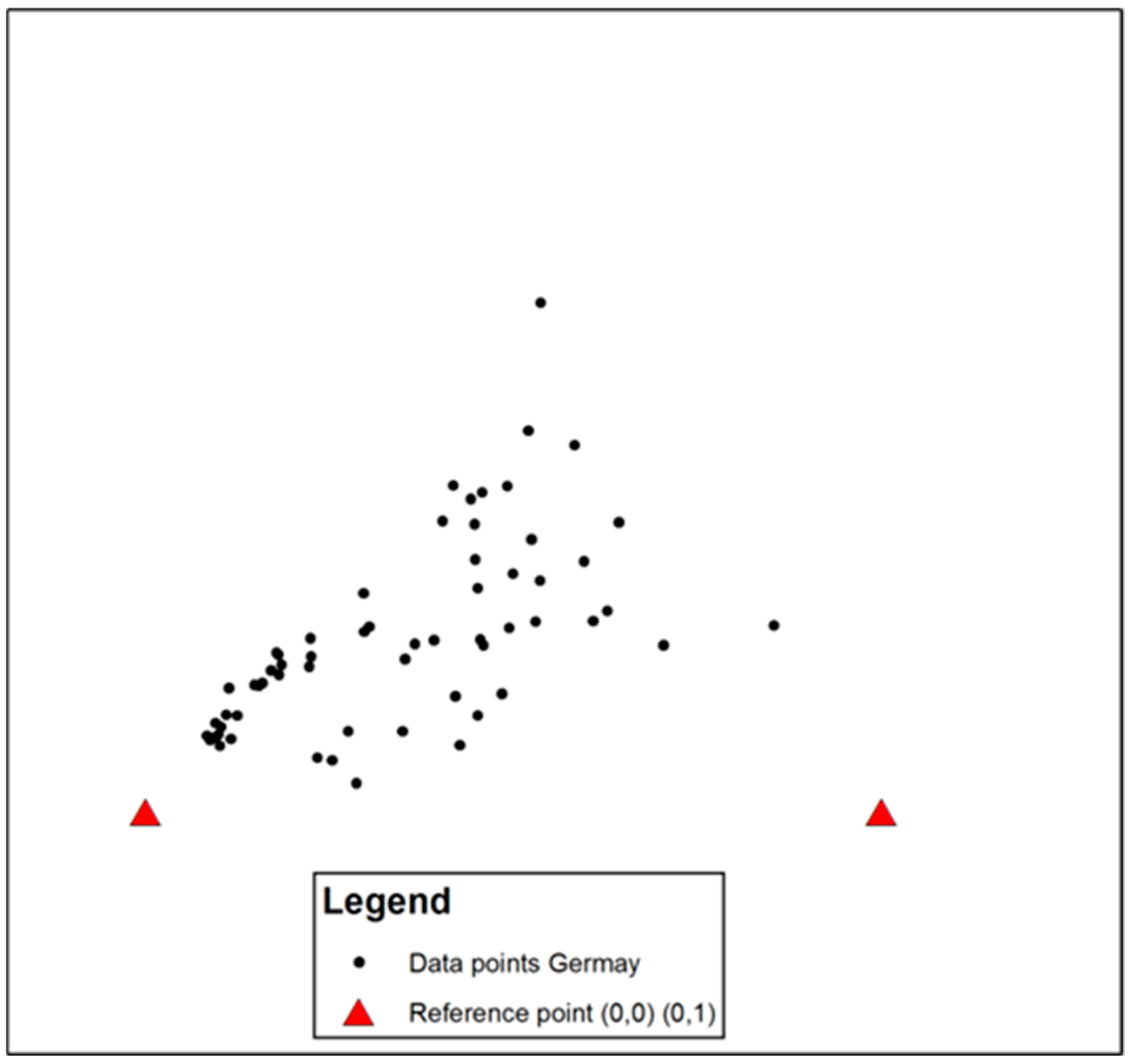

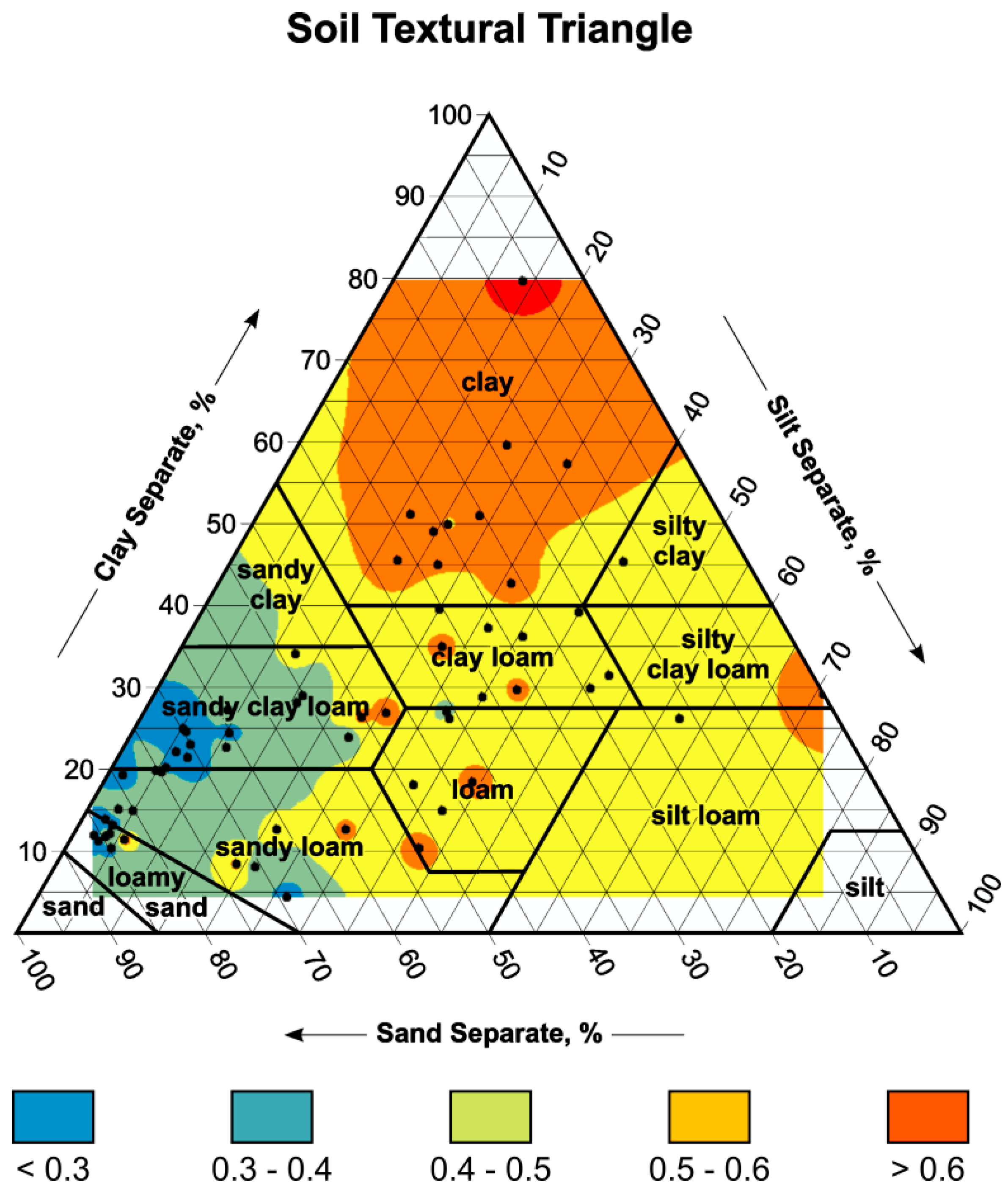

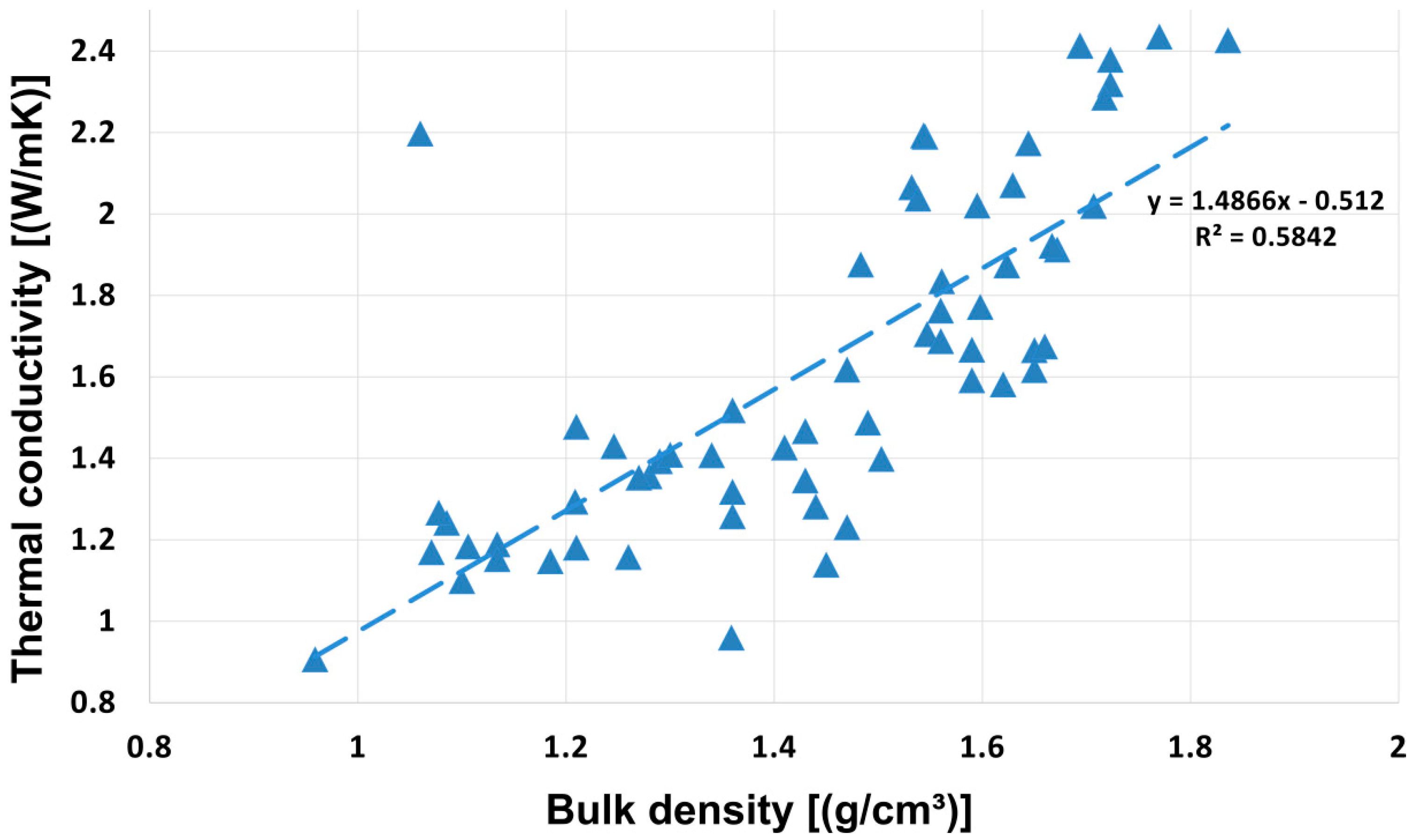


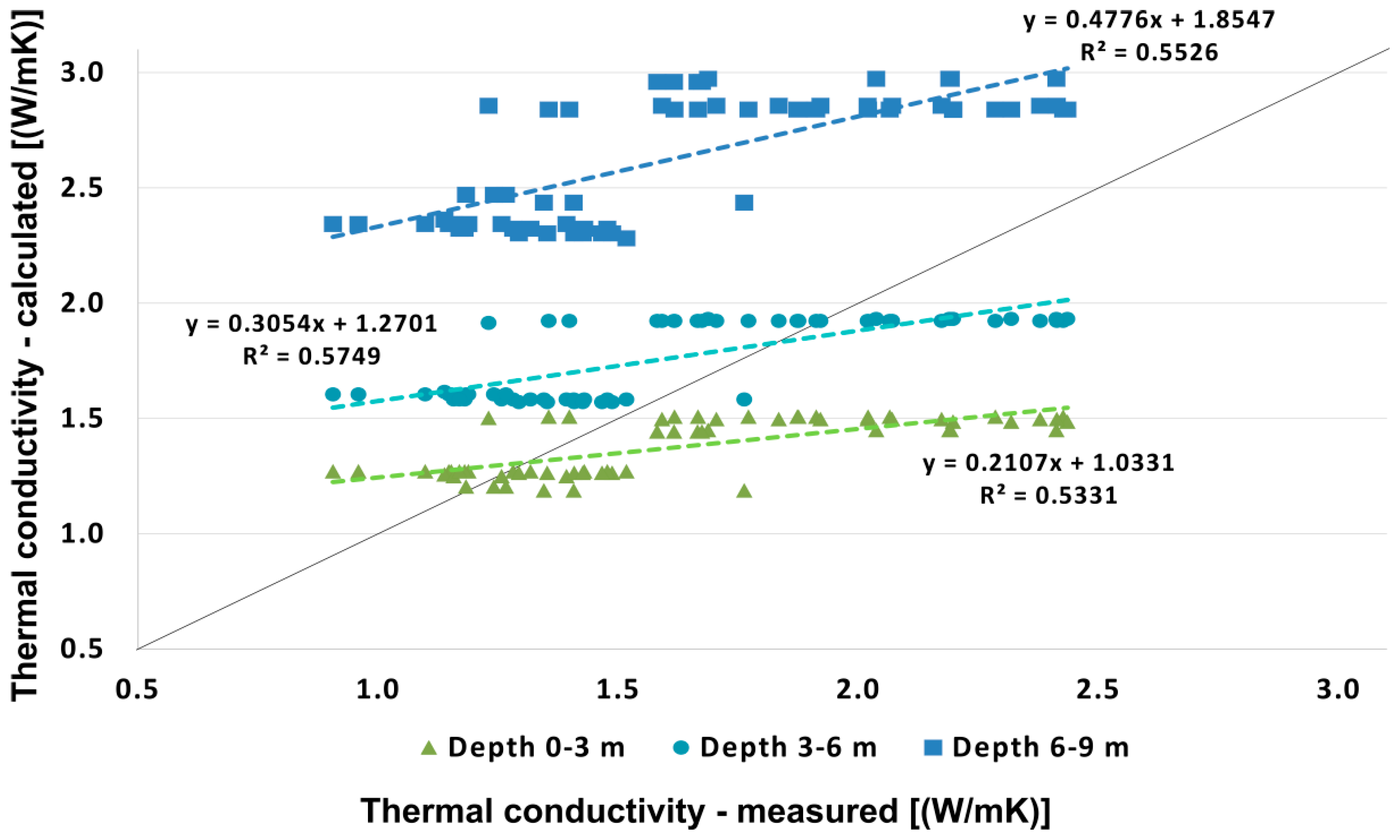
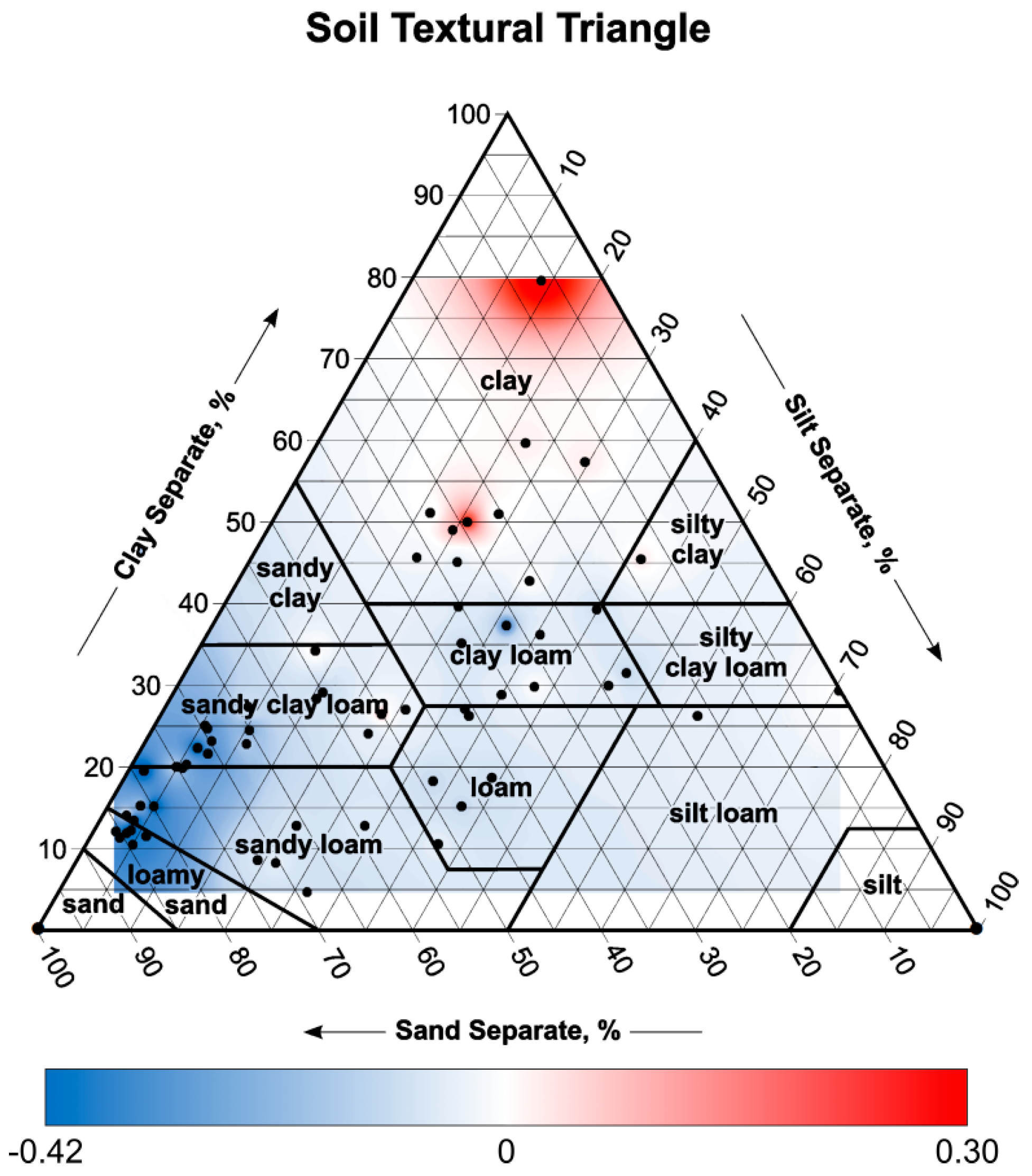
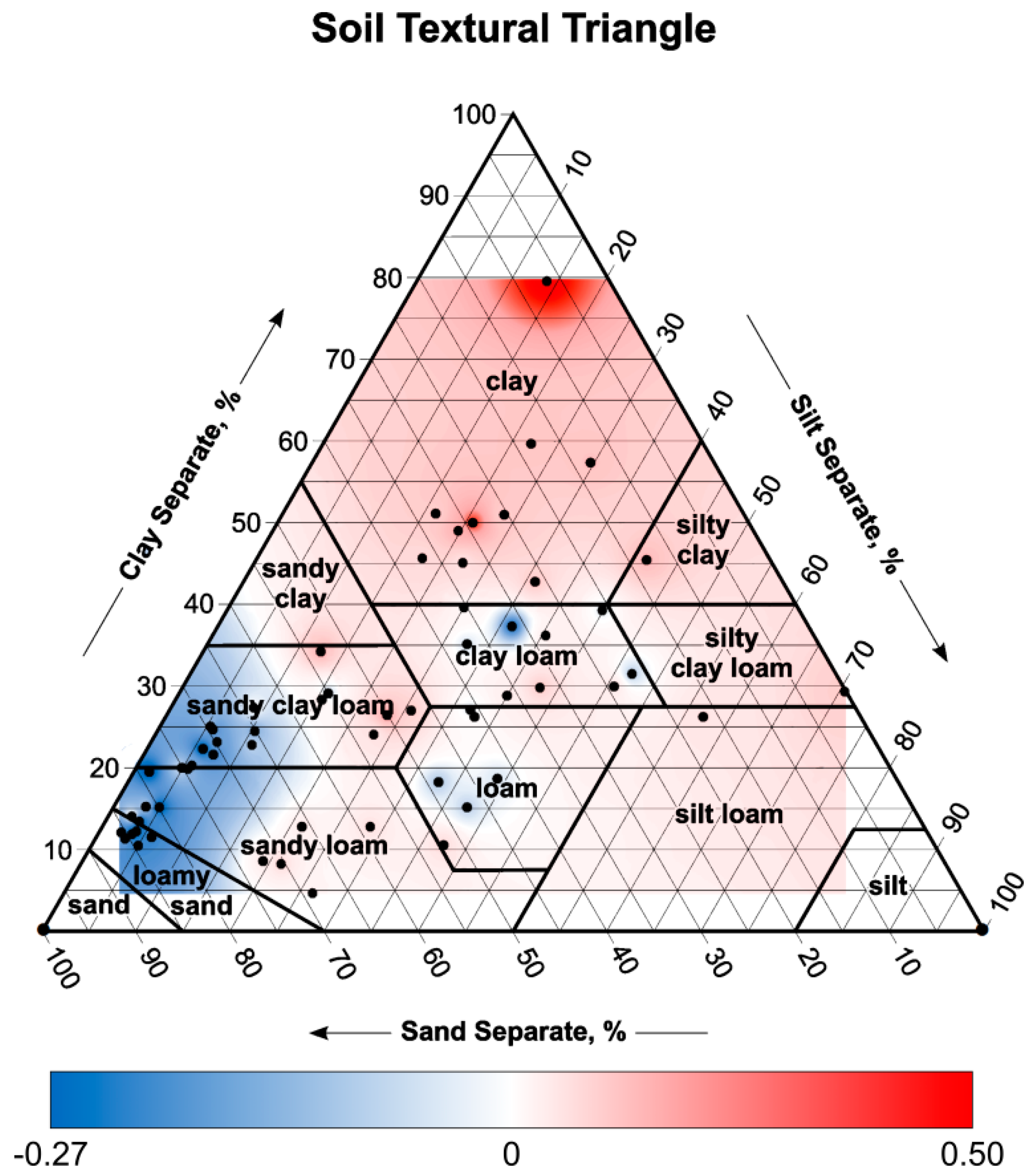

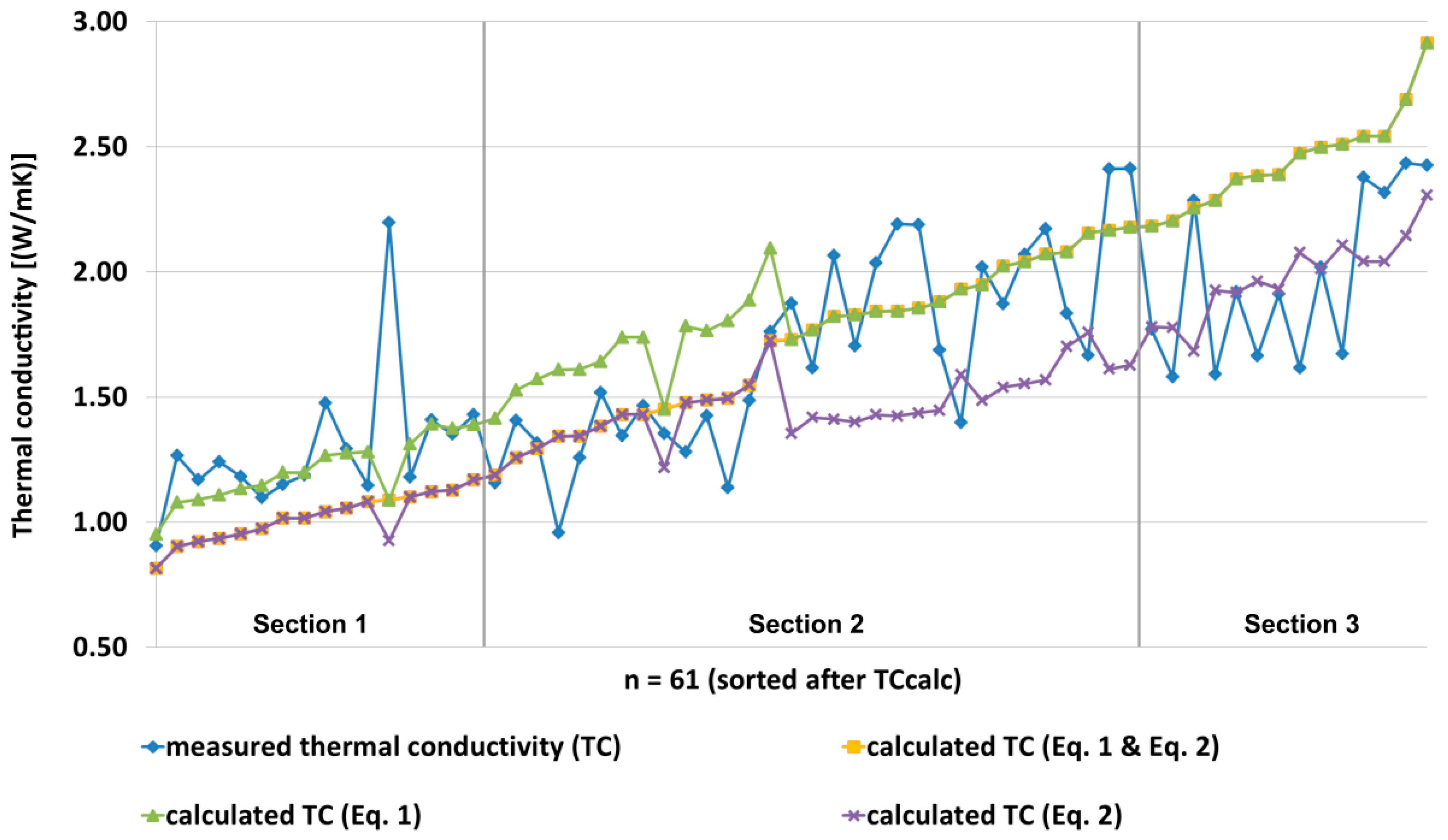
| Classification | Bulk Density [g/cm3] |
|---|---|
| very low | <1.2 |
| low | 1.2–1.4 |
| medium | 1.4–1.6 |
| high | 1.6–1.8 |
| very high | >1.8 |
| Sample-ID | Textural Soil Class | Bulk Density [g/cm³] | Porosity [%] | Thermal Conductivity [W (m·K)−1] | |
|---|---|---|---|---|---|
| TK04 | Kersten (1949) | ||||
| I3 | Loamy Sand | 1.060 | 60.0 | 2.197 | 1.088 |
| II2b | Sandy Loam | 1.561 | 41.0 | 1.834 | 2.080 |
| II3a | Loamy Sand | 1.723 | 35.0 | 2.318 | 2.542 |
| III2a | Sandy Clay Loam | 1.598 | 40.0 | 1.771 | 2.179 |
| III2b | Sandy Clay Loam | 1.836 | 31.0 | 2.426 | 2.910 |
| III3a | Sandy Clay Loam | 1.503 | 43.0 | 1.398 | 1.934 |
| III3b | Clay Loam | 1.246 | 53.0 | 1.429 | 1.169 |
| III4b | Sandy Clay Loam | 1.672 | 37.0 | 1.912 | 2.388 |
| III5a | Clay | 1.359 | 49.0 | 0.959 | 1.341 |
| III5b | Sandy Loam | 1.707 | 36.0 | 2.019 | 2.493 |
| IV2b | Clay | 0.959 | 64.0 | 0.906 | 0.815 |
| IV3a | Clay | 1.185 | 55.0 | 1.147 | 1.084 |
| IV3b | Clay | 1.134 | 57.0 | 1.188 | 1.017 |
| IV4 | Clay | 1.134 | 57.0 | 1.152 | 1.017 |
| RD2 | Clay | 1.085 | 54.6 | 1.241 | 0.936 |
| RD3 | Clay | 1.106 | 52.6 | 1.183 | 0.954 |
| RD4 | Clay | 1.078 | 50.4 | 1.266 | 0.904 |
| RD5 | Sandy Loam | 1.547 | 24.6 | 1.704 | 1.831 |
| RD6 | Clay Loam | 1.071 | 56.2 | 1.169 | 0.924 |
| RD7 | Loam | 1.209 | 45.2 | 1.293 | 1.057 |
| RE1 | Sandy Clay Loam | 1.595 | 23.9 | 2.020 | 1.949 |
| RE2 | Sandy Clay Loam | 1.532 | 26.6 | 2.065 | 1.823 |
| RE3 | Sandy Clay Loam | 1.718 | 21.0 | 2.285 | 2.258 |
| RE4 | Sandy Loam | 1.644 | 22.9 | 2.173 | 2.072 |
| RE5 | Sandy Clay Loam | 1.624 | 23.6 | 1.873 | 2.025 |
| RE6 | Sandy Loam | 1.629 | 23.6 | 2.070 | 2.041 |
| RF1 | Sandy Clay Loam | 1.483 | 28.9 | 1.875 | 1.730 |
| RF2 | Loamy Sand | 1.694 | 20.5 | 2.412 | 2.170 |
| RF3 | Loamy Sand | 1.560 | 25.5 | 1.687 | 1.880 |
| RF4 | Sandy Loam | 1.694 | 21.0 | 2.413 | 2.182 |
| RF5 | Loamy Sand | 1.545 | 26.5 | 2.189 | 1.856 |
| RF6 | Loamy Sand | 1.538 | 26.9 | 2.037 | 1.844 |
| RF7 | Loamy Sand | 1.544 | 26.1 | 2.192 | 1.845 |
| RI-2 | Silt Loam | 1.260 | 52.4 | 1.157 | 1.189 |
| RI-5 | Sandy Clay Loam | 1.590 | 39.9 | 1.666 | 2.156 |
| RIII-2 | Silty Clay | 1.450 | 45.1 | 1.138 | 1.494 |
| RIII-5 | Clay Loam | 1.360 | 43.0 | 1.317 | 1.294 |
| RIV-1b | Sandy Clay Loam | 1.280 | 51.6 | 1.355 | 1.452 |
| RIV-2 | Clay Loam | 1.210 | 54.5 | 1.180 | 1.119 |
| RIV-4 | Clay Loam | 1.440 | 45.6 | 1.281 | 1.478 |
| RIX-1 | Clay | 1.100 | 58.4 | 1.098 | 0.974 |
| RVIII-2 | Loamy Sand | 1.770 | 33.1 | 2.435 | 2.688 |
| V2 | Sandy Loam | 1.667 | 37.0 | 1.921 | 2.373 |
| VA2 | Clay Loam | 1.340 | 43.0 | 1.407 | 1.257 |
| VA3 | Clay Loam | 1.560 | 43.0 | 1.762 | 1.725 |
| VA4 | Clay Loam | 1.430 | 43.0 | 1.345 | 1.431 |
| VA5 | Loam | 1.490 | 42.0 | 1.487 | 1.548 |
| VA6 | Sandy Loam | 1.650 | 52.0 | 1.616 | 2.475 |
| VA7 | Sandy Loam | 1.650 | 43.0 | 1.665 | 2.385 |
| VA8 | Sandy Loam | 1.660 | 52.0 | 1.674 | 2.510 |
| VA9 | Sandy Loam | 1.620 | 36.0 | 1.581 | 2.205 |
| VB1 | Sandy Clay Loam | 1.470 | 35.0 | 1.230 | 1.767 |
| VB10 | Sandy Loam | 1.590 | 54.0 | 1.591 | 2.286 |
| VB2 | Clay Loam | 1.210 | 43.0 | 1.477 | 1.043 |
| VB3 | Sandy Clay Loam | 1.360 | 54.0 | 1.517 | 1.384 |
| VB5 | Loam | 1.300 | 36.0 | 1.408 | 1.122 |
| VB6 | Loam | 1.270 | 42.0 | 1.352 | 1.129 |
| VB7 | Silty Clay Loam | 1.360 | 48.8 | 1.257 | 1.344 |
| VB8 | Loam | 1.430 | 43.0 | 1.466 | 1.431 |
| VB9 | Loam | 1.410 | 54.0 | 1.426 | 1.488 |
| VI3b | Sandy Loam | 1.723 | 35.0 | 2.378 | 2.542 |
| Sample-ID | Textural Soil Class | TC (TK04) [W/(m·K)] | TC ThermoMap [W (m·K)−1] (BD = 1.3 g cm−³) | TC ThermoMap [W (m·K)−1] (BD = 1.5 g cm−³) | TC ThermoMap [W (m·K)−1] (BD = 1.8 g cm−³) |
|---|---|---|---|---|---|
| I3 | Loamy Sand | 2.197 | 1.41 | 1.78 | 2.50 |
| II2b | Sandy Loam | 1.834 | 1.42 | 1.77 | 2.51 |
| II3a | Loamy Sand | 2.318 | 1.41 | 1.78 | 2.50 |
| III2a | Sandy Clay Loam | 1.771 | 1.43 | 1.77 | 2.50 |
| III2b | Sandy Clay Loam | 2.426 | 1.43 | 1.77 | 2.50 |
| III3a | Sandy Clay Loam | 1.398 | 1.43 | 1.77 | 2.50 |
| III3b | Clay Loam | 1.429 | 1.17 | 1.38 | 1.88 |
| III4b | Sandy Clay Loam | 1.912 | 1.43 | 1.77 | 2.50 |
| III5a | Clay | 0.959 | 1.17 | 1.41 | 1.90 |
| III5b | Sandy Loam | 2.019 | 1.42 | 1.77 | 2.51 |
| IV2b | Clay | 0.906 | 1.17 | 1.41 | 1.90 |
| IV3a | Clay | 1.147 | 1.17 | 1.41 | 1.90 |
| IV3b | Clay | 1.188 | 1.17 | 1.41 | 1.90 |
| IV4 | Clay | 1.152 | 1.17 | 1.41 | 1.90 |
| RD2 | Clay | 1.241 | 1.17 | 1.41 | 1.90 |
| RD3 | Clay | 1.183 | 1.17 | 1.41 | 1.90 |
| RD4 | Clay | 1.266 | 1.17 | 1.41 | 1.90 |
| RD5 | Sandy Loam | 1.704 | 1.42 | 1.77 | 2.51 |
| RD6 | Clay Loam | 1.169 | 1.17 | 1.38 | 1.88 |
| RD7 | Loam | 1.293 | 1.17 | 1.37 | 1.86 |
| RE1 | Sandy Clay Loam | 2.020 | 1.43 | 1.77 | 2.50 |
| RE2 | Sandy Clay Loam | 2.065 | 1.43 | 1.77 | 2.50 |
| RE3 | Sandy Clay Loam | 2.285 | 1.43 | 1.77 | 2.50 |
| RE4 | Sandy Loam | 2.173 | 1.42 | 1.77 | 2.51 |
| RE5 | Sandy Clay Loam | 1.873 | 1.43 | 1.77 | 2.50 |
| RE6 | Sandy Loam | 2.070 | 1.42 | 1.77 | 2.51 |
| RF1 | Sandy Clay Loam | 1.875 | 1.43 | 1.77 | 2.50 |
| RF2 | Loamy Sand | 2.412 | 1.41 | 1.78 | 2.50 |
| RF3 | Loamy Sand | 1.687 | 1.41 | 1.78 | 2.50 |
| RF4 | Sandy Loam | 2.413 | 1.42 | 1.77 | 2.51 |
| RF5 | Loamy Sand | 2.189 | 1.41 | 1.78 | 2.50 |
| RF6 | Loamy Sand | 2.037 | 1.41 | 1.78 | 2.50 |
| RF7 | Loamy Sand | 2.192 | 1.41 | 1.78 | 2.50 |
| RI-2 | Silt Loam | 1.157 | 1.15 | 1.38 | 1.90 |
| RI-5 | Sandy Clay Loam | 1.666 | 1.43 | 1.77 | 2.50 |
| RIII-2 | Silty Clay | 1.138 | 1.16 | 1.42 | 1.92 |
| RIII-5 | Clay Loam | 1.317 | 1.17 | 1.38 | 1.88 |
| RIV-1b | Sandy Clay Loam | 1.355 | 1.43 | 1.77 | 2.50 |
| RIV-2 | Clay Loam | 1.180 | 1.17 | 1.38 | 1.88 |
| RIV-4 | Clay Loam | 1.281 | 1.17 | 1.38 | 1.88 |
| RIX-1 | Clay | 1.098 | 1.17 | 1.41 | 1.90 |
| RVIII-2 | Loamy Sand | 2.435 | 1.41 | 1.78 | 2.50 |
| V2 | Sandy Loam | 1.921 | 1.42 | 1.77 | 2.51 |
| VA2 | Clay Loam | 1.407 | 1.17 | 1.38 | 1.88 |
| VA3 | Clay Loam | 1.762 | 1.17 | 1.38 | 1.88 |
| VA4 | Clay Loam | 1.345 | 1.17 | 1.38 | 1.88 |
| VA5 | Loam | 1.487 | 1.17 | 1.37 | 1.86 |
| VA6 | Sandy Loam | 1.616 | 1.42 | 1.77 | 2.51 |
| VA7 | Sandy Loam | 1.665 | 1.42 | 1.77 | 2.51 |
| VA8 | Sandy Loam | 1.674 | 1.42 | 1.77 | 2.51 |
| VA9 | Sandy Loam | 1.581 | 1.42 | 1.77 | 2.51 |
| VB1 | Sandy Clay Loam | 1.230 | 1.43 | 1.77 | 2.50 |
| VB10 | Sandy Loam | 1.591 | 1.42 | 1.77 | 2.51 |
| VB2 | Clay Loam | 1.477 | 1.17 | 1.38 | 1.88 |
| VB3 | Sandy Clay Loam | 1.517 | 1.43 | 1.77 | 2.50 |
| VB5 | Loam | 1.408 | 1.17 | 1.37 | 1.86 |
| VB6 | Loam | 1.352 | 1.17 | 1.37 | 1.86 |
| VB7 | Silty Clay Loam | 1.257 | 1.17 | 1.40 | 1.90 |
| VB8 | Loam | 1.466 | 1.17 | 1.37 | 1.86 |
| VB9 | Loam | 1.426 | 1.17 | 1.37 | 1.86 |
| VI3b | Sandy Loam | 2.378 | 1.42 | 1.77 | 2.51 |
© 2018 by the authors. Licensee MDPI, Basel, Switzerland. This article is an open access article distributed under the terms and conditions of the Creative Commons Attribution (CC BY) license (http://creativecommons.org/licenses/by/4.0/).
Share and Cite
Bertermann, D.; Müller, J.; Freitag, S.; Schwarz, H. Comparison between Measured and Calculated Thermal Conductivities within Different Grain Size Classes and Their Related Depth Ranges. Soil Syst. 2018, 2, 50. https://doi.org/10.3390/soilsystems2030050
Bertermann D, Müller J, Freitag S, Schwarz H. Comparison between Measured and Calculated Thermal Conductivities within Different Grain Size Classes and Their Related Depth Ranges. Soil Systems. 2018; 2(3):50. https://doi.org/10.3390/soilsystems2030050
Chicago/Turabian StyleBertermann, David, Johannes Müller, Simon Freitag, and Hans Schwarz. 2018. "Comparison between Measured and Calculated Thermal Conductivities within Different Grain Size Classes and Their Related Depth Ranges" Soil Systems 2, no. 3: 50. https://doi.org/10.3390/soilsystems2030050
APA StyleBertermann, D., Müller, J., Freitag, S., & Schwarz, H. (2018). Comparison between Measured and Calculated Thermal Conductivities within Different Grain Size Classes and Their Related Depth Ranges. Soil Systems, 2(3), 50. https://doi.org/10.3390/soilsystems2030050






